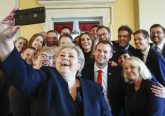
Just under a year ago the first Police and Crime Commissioner elections were held in England and Wales. Two weeks ago, the Electoral Commission released data on candidate donations and spending at those elections. In total, candidates spent £2.1 million – an average of £11,220 each. For comparison, candidates at the 2010 general election only spent £6,284 each (but this doesn’t count party spending, which was much lower at the Police Commissioner elections). Media reporting of the data tended to concentrate on the more extreme cases of candidate spending – the Conservative candidate who spent £98,751 and didn’t win, or the independent candidate who (officially at least) didn’t spend a single penny and won.
The casual observer might then be forgiven for thinking that candidate spending had no impact on the outcome of the Police Commissioner elections. However, as any good social scientist will tell you, outliers often obscure trends rather than indicate them.
Campaign spending is a much studied topic in political science and the consensus is that spending more money gets more votes. One of the key insights about campaign spending is that it tends not to change voters’ minds about who to vote for but rather whether or not they bother turning out to vote at all.
With this in mind and given the fact that turnout at the Police Commissioner elections was a record low 15%, I decided to subject the data released by the Electoral Commission to some quick statistical analysis.[1] The results are unambiguous: spending more money increased a candidate’s probability of winning the election. Perhaps more interestingly though is that the effect of spending was different depending on the party of the candidate. As I’ve illustrated in the graph below, the effect of campaign spending is most pronounced for Labour: when a Labour candidate doesn’t spend much money they have a tiny chance of winning, but if they spend enough money the model predicts victory with near certainty. In contrast, the effect of spending for Conservative candidates is much more muted: although spending more money increases their probability of winning, they have to spend much more than Labour candidates for a fraction of the result.

We should of course take these results with a grain of salt – the sample size is quite small. The near certainty of a predicted Labour victory above a certain threshold is largely driven by five Labour candidates who spent over £28,000, all of whom were victorious (by contrast 11 Conservative candidates spent more than £28,000 but only 5 of those won). I do think though that the model is capturing some real difference between the effects of Conservative and Labour spending, even if those differences are likely to be more muted in reality. From a purely demographic perspective, Conservative voters – who tend to be older and richer than other voters – are also those who are more likely to turn out in general. We shouldn’t be surprised then that campaign spending – which largely operates on turnout – has more effect for candidates whose voters require a little more persuasion to get out and vote, than those who will turnout regardless.
The Electoral Commission also provides a brief breakdown on what candidates actually spent their money on, illustrated in the graph below. In order to investigate the effects of spending on different types of things, I substituted the breakdown of spending for the total amount candidates spent and re-ran my model. Again the results are unambiguous: only one type of spending had any influence on electoral outcomes – what the Electoral Commission calls ‘unsolicited materials’. These are the flyers that come flooding in through your door at every election. This is good news for political parties, who spend much of their resources on printing and distributing these flyers at every election. Alas, this is not great news for those of us who wish we didn’t have to fill our recycling bins quite so high come election time.

[1] Technical details: I ran a conditional logit model with total candidate spending and interactions between Labour and Conservative spending (there is not enough variation on the outcome for other parties – the Liberal Democrats and UKIP did not win any Police Commissionerships – to include interaction terms for them so they are bundled together with the other minor parties and independents. The results are offered here ‘as is’ and with the large disclaimer that the sample size is quite small and I’m not controlling for any other variables.








3 Comments
Interesting and useful analysis, Chris. You’re right about the grain of salt, but the findings are still important. Isn’t there a further caveat that candidates won’t spend much, possibly even nothing, where they go into the contest knowing they have little chance of victory? So aren’t you partly capturing what candidates opted to spend where they felt they had a realistic chance of winning? Obviously, there was no sense of what might be ‘marginal’ contests, and there were quite a few independent candidates who did surprisingly well. But some PCC contests were very clearly ‘safe’ Labour or Conservative – presumably the spending patterns reflect that? It’s the impact of candidate spending in areas where there was assumed to be a genuine contest which really matters, doesn’t it?
Thanks Stuart. You’re right of course, endogeneity is a potential problem here. I guess ideally I would only include ‘serious’ candidates in the analysis – though trying to decide which candidates meet that description is a bit of a minefield! The conditional logit model might take some of your concerns into account though because it estimates the effect of candidate spending ‘conditional’ on the spending of other candidates in that constituency – so if spending is higher in close races and lower in ‘safe’ races it shouldn’t bias the results.
Arguably endogeneity might be less of a problem for the PCC than other elections because they were so open in many respects – PCC constituencies that don’t map onto usual constituencies, there was no incumbent, and the turnout was always anticipated to be low. The only way to get around the endogeneity problem really is to use experimental methods, which on the whole tend to support the general findings of observational studies of campaign spending (such as this one: http://abs.sagepub.com/content/47/5/541.abstract). So all in all, although endogeneity almost certainly introduces some bias to the model I don’t think its driving the results (though I still recommend that grain of salt!).